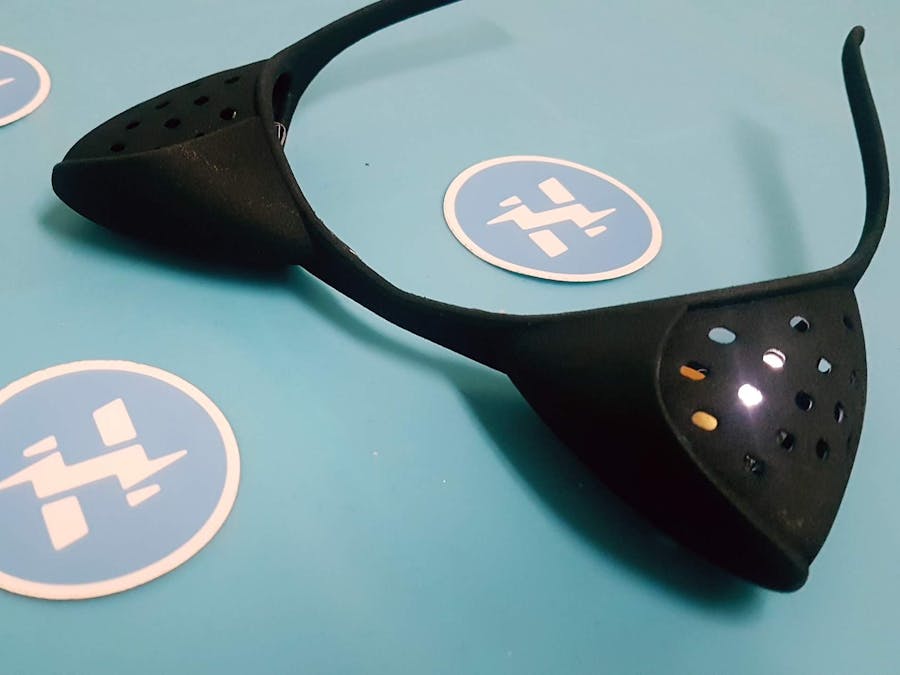LIGHT UP KITTY EARS! It's the second iteration of the cat ears so feel free to redesign, remix, reprogram or even reverse engineer anything and everything that I am about to show you! <3
This time - with the boards being printed at OSHPark, and an Hackster.io tutorial by me and Alex Glow that shows you how to solder these cute little boards!
- 3D printed CAT EAR headset which you can find attached
- the custom PCB (either mill it or order one at OSHPark)
- a set of electronic parts found above
To program the ATtiny you need:
- jumping wires (M/M)
Tools you need: soldering iron, soldering wick, pliers, wire + your computer with Arduino installed.
The Kitty Ears can be obtained in a few ways, which you can choose from below:
- 1. Get them from Shapeways [EASY] Just CLICK THIS LINK and order them!
[SLS printing can be expensive but the quality is absolutely the best. But just to point out - I don't take a markup myself (meaning - I don't receive money for this!) the costs are printing costs only]
- 2. Print them yourself [MEDIUM] I added a link (.STL file) below. Download the file and import it to the 3D printer of your choice to 3D print the headset yourself. NOTE - you might need to tweak, cut, or align the design a bit to be printed well, as the design is originally created for SLS printing (powder printing) like Shapeways would print it for you. If it worked on your machine - let me know or share your results! I am using the OBJET Connex 500, and a Dremel 3D45 3D Printer and the results are good aside from support removal and polishing.
- 3. Redesign them with Fusion360 [EXPERT] In Fusion360 - AutoDesk's cool freeform and solid modelling software, you are able to import your file and customise from there. Whether you are new to CAD or already using parametric CAD software, Fusion360 can be cool for you to look into. You can find some tutorials on Instructables (like building a lamp) on how to work with this piece of software.
Now - the circuit board will host the BRAIN of your design (the chip - in this case the ATtiny) amongst some other of the electronics. There are a few ways you can get the CUSTOM PCB's created with AUTODESK EAGLE:
- 1. Get them from OSHPARK (if you are in USA): HERE is the link to order the PCB's from OSHpark (3 boards for $13.20)
- 2. Mill them out yourself: If you have a mill, you can mill them out; we succeeded using an Othermill, the file is a bit different for this (see next step. I would say - this would be an easy solution and by def. the cheapest one around. So it might be worth checking your local Makerspace, Hackerspace, Fablab or TechShop if they have an mill that you can use)
- 3. Be creative: draw your circuit with conductive ink! This is an expertise question, but if you use conductive ink you might be able to draw the traces out by hand. Either way - if this experiment works out - let me know! ^^ #ElectronicKittyEars on twitter!
You can skip this step when you are ordering your boards, but might you want to mill them out yourself - see Gerber ZIP file.
NOTE: since there are no plated through-holes, we added a large through-hole "test point" under the ATtiny to route one of the signals out. So a wire will need to be added through that hole and soldered on both sides if hole plating is not present!!
- Digikey (8) C512A-WNN-CZ0B0151-ND (8 leds in total, each pair)
- Digikey (1) ATTINY85-20PU-ND (1 ATtiny in total, each pair)
- Digikey (1) BAT-HLD-001-THM-ND (1 battery holder, each pair)
- Digikey (2) 10.0AYTB-ND (2 resistors, 10 Ohm, each pair)
- Digikey (1) P8010S-ND (1 button, each pair)
- Digikey (1) P189-ND (1 3V coin cell battery, each pair*)
* feel free to take more coin cell batteries for if they empty out ;)
The first step is to take all elements and put them together on the board in the correct way so it looks like attached layout. NOTE that the both boards are not similar; they both are occupied differently:
The left board has the:- 4 LEDs
- 2 resistors
- Battery holder
- ATtiny
- 4 LEDs
- Button
Here an small movie on how exactly to put the parts in.
To be sure:Ready? No - for sure not: You're missing your BRAIN! This is where the ATtiny comes in: the microcontroller.ATtiny is a cheap and powerful alternate when u don't need too many PWM pins. Since ATtiny85 is just a microcontroller we need a Arduino (Uno) to program. Otherwise our circuitry would be wayyy too big ;) Let's do it!
ARDUINO.CC INSTALLED? Make sure you have ARDUINO.CC installed on your computer (it's free // open source) or are working on a computer with the latest version of Arduino installed! Install ATtiny support on here if it's non discoverable.
COPY THE CODE! Attached (underneath) is the code - download this and place this in your 'Arduino' folder
PROGRAM THE ATtiny >> To program the ATtiny you need;
- jumping wires (M/M)
- follow THIS INSTRUCTABLES TO KNOW HOW using the code that is attached to this step.
This is another way, but you need a few more parts for it: 'Program an ATtiny With Arduino' This way you have an LED indicator. For this, you will need:
- Arduino
- Breadboard
- ATtiny85 (or ATtiny45)
- 10uF 16V electrolytic capacitor
- 220ohm 1/4 watt resistor
- LED
- solid core hookup wire
- Arduino +5V ---> ATtiny Pin 8
- Arduino Ground ---> ATtiny Pin 4
- Arduino Pin 10 ---> ATtiny Pin 1
- Arduino Pin 11 ---> ATtiny Pin 5
- Arduino Pin 12 ---> ATtiny Pin 6
- Arduino Pin 13 ---> ATtiny Pin 7
After this, upload the sketch (code) to your Arduino as you would any other sketch.
Next up once you flashed in the animation for the LED, you can solder it directly to the board if you want!
NOTE the orientation!! [IMPORTANT] - there is a white dot on the PCB, it corresponds with the little dot/dent in the ATtiny - align them! So they both point the same direction.
Solder ahead! Make sure the tip of your soldering iron is clean! Since the legs are pretty close together.
IF CORRECT - the next step what you can do is put the battery into the right ear and see if it flashes!
There are 3 animations in the chip: a chase, a glow and a twinkle, which will be followed by a short time-out [so don't think it's broken, when t's just resting;)] >> if this is allright you can wire the two ears together so you have access to the on/off button! :)
Then:
Put them back into the headset (align the wire in the piece between the two ears) I personally keep them loose in the headset so I can take them out and change the battery. Another smart thing to do is to extend the button with an wire that you can mount on the side of the headset so it's easier reachable (or model a hole!).
CUSTOMISE!... And why leave these ears BLACK (?) No need! Get some fluff, make them fluffy, or take a marker and customise your ears to your style! Let's make our pawed friends proud <3














_t9PF3orMPd.png?auto=compress%2Cformat&w=40&h=40&fit=fillmax&bg=fff&dpr=2)


Comments